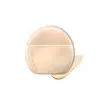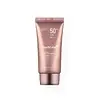What's inside
What's inside
 Key Ingredients
Key Ingredients

 Benefits
Benefits

 Concerns
Concerns

 Ingredients Side-by-side
Ingredients Side-by-side

Cyclopentasiloxane
EmollientWater
Skin ConditioningZinc Oxide
Cosmetic ColorantEthylhexyl Methoxycinnamate
UV AbsorberCI 77891
Cosmetic ColorantTitanium Dioxide
Cosmetic ColorantCetyl PEG/PPG-10/1 Dimethicone
EmulsifyingDimethicone
EmollientGlycerin
HumectantButylene Glycol
HumectantNeopentyl Glycol Diethylhexanoate
EmollientTrimethylsiloxysilicate
EmollientPhenylbenzimidazole Sulfonic Acid
UV AbsorberPolysilicone-15
UV FilterPentylene Glycol
Skin ConditioningPEG-10 Dimethicone
Skin ConditioningSilica
AbrasiveMethylene Bis-Benzotriazolyl Tetramethylbutylphenol
UV FilterHdi/Trimethylol Hexyllactone Crosspolymer
Aminomethyl Propanol
BufferingMagnesium Sulfate
Phenoxyethanol
PreservativeCI 77492
Cosmetic ColorantTriethoxycaprylylsilane
Disteardimonium Hectorite
StabilisingDextrin Palmitate
EmulsifyingBifida Ferment Filtrate
Skin ConditioningAluminum Hydroxide
EmollientDimethicone Crosspolymer
Emulsion StabilisingSilica Dimethyl Silylate
EmollientDecyl Glucoside
CleansingStearic Acid
CleansingSodium Stearoyl Glutamate
CleansingCI 77491
Cosmetic ColorantBisabolol
MaskingCI 77499
Cosmetic ColorantEthylhexylglycerin
Skin ConditioningCamellia Sinensis Leaf Water
MaskingParfum
MaskingCoix Lacryma-Jobi Ma-Yuen Seed Water
Skin ConditioningMica
Cosmetic ColorantPanax Ginseng Root Water
MaskingSqualane
EmollientCyclodextrin
AbsorbentPropylene Glycol
HumectantXanthan Gum
EmulsifyingBHT
Antioxidant1,2-Hexanediol
Skin ConditioningRoyal Jelly Extract
Skin ConditioningCaprylhydroxamic Acid
Centella Asiatica Extract
CleansingHydroxyacetophenone
AntioxidantPortulaca Oleracea Extract
Skin ConditioningCyclopentasiloxane, Water, Zinc Oxide, Ethylhexyl Methoxycinnamate, CI 77891, Titanium Dioxide, Cetyl PEG/PPG-10/1 Dimethicone, Dimethicone, Glycerin, Butylene Glycol, Neopentyl Glycol Diethylhexanoate, Trimethylsiloxysilicate, Phenylbenzimidazole Sulfonic Acid, Polysilicone-15, Pentylene Glycol, PEG-10 Dimethicone, Silica, Methylene Bis-Benzotriazolyl Tetramethylbutylphenol, Hdi/Trimethylol Hexyllactone Crosspolymer, Aminomethyl Propanol, Magnesium Sulfate, Phenoxyethanol, CI 77492, Triethoxycaprylylsilane, Disteardimonium Hectorite, Dextrin Palmitate, Bifida Ferment Filtrate, Aluminum Hydroxide, Dimethicone Crosspolymer, Silica Dimethyl Silylate, Decyl Glucoside, Stearic Acid, Sodium Stearoyl Glutamate, CI 77491, Bisabolol, CI 77499, Ethylhexylglycerin, Camellia Sinensis Leaf Water, Parfum, Coix Lacryma-Jobi Ma-Yuen Seed Water, Mica, Panax Ginseng Root Water, Squalane, Cyclodextrin, Propylene Glycol, Xanthan Gum, BHT, 1,2-Hexanediol, Royal Jelly Extract, Caprylhydroxamic Acid, Centella Asiatica Extract, Hydroxyacetophenone, Portulaca Oleracea Extract
Water
Skin ConditioningPropanediol
SolventCI 77891
Cosmetic ColorantButyloctyl Salicylate
Skin ConditioningIsononyl Isononanoate
EmollientC12-15 Alkyl Benzoate
AntimicrobialCoco-Caprylate/Caprate
EmollientAcrylates Copolymer
Diethylamino Hydroxybenzoyl Hexyl Benzoate
UV FilterDiisostearyl Malate
EmollientDipentaerythrityl Hexa C5-9 Acid Esters
Skin ConditioningNiacinamide
SmoothingPolyglyceryl-6 Stearate
EmollientC14-22 Alcohols
Emulsion StabilisingChlorella Vulgaris Extract
Skin ConditioningSodium Hyaluronate
HumectantHydrolyzed Collagen
EmollientSoluble Collagen
HumectantCollagen
MoisturisingCollagen Extract
Skin ConditioningHydrolyzed Hyaluronic Acid
HumectantHyaluronic Acid
HumectantEthylhexyl Triazone
UV Absorber1,2-Hexanediol
Skin ConditioningPolyhydroxystearic Acid
EmulsifyingMethylene Bis-Benzotriazolyl Tetramethylbutylphenol
UV FilterAluminum Hydroxide
EmollientPanthenol
Skin ConditioningPotassium Cetyl Phosphate
EmulsifyingPolyacrylate-13
Stearic Acid
CleansingC12-20 Alkyl Glucoside
EmulsifyingAmmonium Acryloyldimethyltaurate/Vp Copolymer
Hydroxyacetophenone
AntioxidantPolyisobutene
Glucose
HumectantPolyglyceryl-6 Behenate
Emulsion StabilisingButylene Glycol
HumectantFructooligosaccharides
HumectantFructose
HumectantPolyglyceryl-2 Dipolyhydroxystearate
Skin ConditioningHydroxyethyl Acrylate/Sodium Acryloyldimethyl Taurate Copolymer
Emulsion StabilisingDecyl Glucoside
CleansingIsododecane
EmollientOctyldodecanol
EmollientAdenosine
Skin ConditioningPolysorbate 20
EmulsifyingGlycerin
HumectantSorbitan Isostearate
EmulsifyingPolyglyceryl-4 Isostearate
EmulsifyingIsopropyl Titanium Triisostearate
EmollientEthylhexylglycerin
Skin ConditioningCaprylic/Capric Triglyceride
MaskingHydrogenated Lecithin
EmulsifyingGlycine
BufferingSerine
MaskingGlutamic Acid
HumectantCeramide NP
Skin ConditioningBenzyl Glycol
SolventAspartic Acid
MaskingLeucine
Skin ConditioningHydrolyzed Glycosaminoglycans
HumectantAlanine
MaskingLysine
Skin ConditioningArginine
MaskingTyrosine
MaskingPhenylalanine
MaskingProline
Skin ConditioningThreonine
Valine
MaskingIsoleucine
Skin ConditioningHistidine
HumectantCysteine
AntioxidantMethionine
Skin ConditioningSodium Hyaluronate Crosspolymer
HumectantHydroxypropyltrimonium Hyaluronate
Sodium Stearoyl Glutamate
CleansingSodium Acetylated Hyaluronate
HumectantBehenyl Alcohol
EmollientXanthan Gum
EmulsifyingDisodium EDTA
Parfum
MaskingCI 77492
Cosmetic ColorantCI 77491
Cosmetic ColorantWater, Propanediol, CI 77891, Butyloctyl Salicylate, Isononyl Isononanoate, C12-15 Alkyl Benzoate, Coco-Caprylate/Caprate, Acrylates Copolymer, Diethylamino Hydroxybenzoyl Hexyl Benzoate, Diisostearyl Malate, Dipentaerythrityl Hexa C5-9 Acid Esters, Niacinamide, Polyglyceryl-6 Stearate, C14-22 Alcohols, Chlorella Vulgaris Extract, Sodium Hyaluronate, Hydrolyzed Collagen, Soluble Collagen, Collagen, Collagen Extract, Hydrolyzed Hyaluronic Acid, Hyaluronic Acid, Ethylhexyl Triazone, 1,2-Hexanediol, Polyhydroxystearic Acid, Methylene Bis-Benzotriazolyl Tetramethylbutylphenol, Aluminum Hydroxide, Panthenol, Potassium Cetyl Phosphate, Polyacrylate-13, Stearic Acid, C12-20 Alkyl Glucoside, Ammonium Acryloyldimethyltaurate/Vp Copolymer, Hydroxyacetophenone, Polyisobutene, Glucose, Polyglyceryl-6 Behenate, Butylene Glycol, Fructooligosaccharides, Fructose, Polyglyceryl-2 Dipolyhydroxystearate, Hydroxyethyl Acrylate/Sodium Acryloyldimethyl Taurate Copolymer, Decyl Glucoside, Isododecane, Octyldodecanol, Adenosine, Polysorbate 20, Glycerin, Sorbitan Isostearate, Polyglyceryl-4 Isostearate, Isopropyl Titanium Triisostearate, Ethylhexylglycerin, Caprylic/Capric Triglyceride, Hydrogenated Lecithin, Glycine, Serine, Glutamic Acid, Ceramide NP, Benzyl Glycol, Aspartic Acid, Leucine, Hydrolyzed Glycosaminoglycans, Alanine, Lysine, Arginine, Tyrosine, Phenylalanine, Proline, Threonine, Valine, Isoleucine, Histidine, Cysteine, Methionine, Sodium Hyaluronate Crosspolymer, Hydroxypropyltrimonium Hyaluronate, Sodium Stearoyl Glutamate, Sodium Acetylated Hyaluronate, Behenyl Alcohol, Xanthan Gum, Disodium EDTA, Parfum, CI 77492, CI 77491
 Reviews
Reviews

Ingredients Explained
These ingredients are found in both products.
Ingredients higher up in an ingredient list are typically present in a larger amount.
1,2-Hexanediol is a synthetic liquid and another multi-functional powerhouse.
It is a:
- Humectant, drawing moisture into the skin
- Emollient, helping to soften skin
- Solvent, dispersing and stabilizing formulas
- Preservative booster, enhancing the antimicrobial activity of other preservatives
Aluminum Hydroxide is a form of aluminum. It can be naturally found in nature as the mineral gibbsite. In cosmetics, Aluminum Hydroxide is used as a colorant, pH adjuster, and absorbent.
As a colorant, Aluminum Hydroxide may add opacity, or reduce the transparency. Aluminum hydroxide is contains both basic and acidic properties.
According to manufacturers, this ingredient is an emollient and humectant. This means it helps hydrate the skin.
In medicine, this ingredient is used to help relieve heartburn and help heal ulcers.
There is currently no credible scientific evidence linking aluminum hydroxide in cosmetics to increased cancer risk.
Major health organizations allow the use of aluminum hydroxide in personal care products and have not flagged it as a carcinogenic risk at typical usage levels.
Learn more about Aluminum HydroxideButylene Glycol (or BG) is used within cosmetic products for a few different reasons:
Overall, Butylene Glycol is a safe and well-rounded ingredient that works well with other ingredients.
Though this ingredient works well with most skin types, some people with sensitive skin may experience a reaction such as allergic rashes, closed comedones, or itchiness.
Learn more about Butylene GlycolCi 77491 is also hydrated iron III oxide. It's sole purpose is to give a red/pink hue to products.
Iron III oxides are classified as inorganic chemicals for coloring.
Synthetically created Ci 77491 is considered safer than those naturally found. This is because the synthetically created version may contain less impurities. Iron oxides are generally non-toxic and non-allergenic.
Learn more about CI 77491Ci 77492 is also hydrated iron III oxide. It's sole purpose is to give a yellow hue to products.
Iron III oxides are classified as inorganic chemicals for coloring.
Synthetically created Ci 77492 is considered safer than those naturally found. This is because the synthetically created version may contain less impurities. Iron oxides are generally non-toxic and non-allergenic.
Learn more about CI 77492Ci 77891 is a white pigment from Titanium dioxide. It is naturally found in minerals such as rutile and ilmenite.
It's main function is to add a white color to cosmetics. It can also be mixed with other colors to create different shades.
Ci 77891 is commonly found in sunscreens due to its ability to block UV rays.
Learn more about CI 77891Decyl Glucoside is a glucose-based surfactant and emulsion stabilizer. It is created by reacting glucose with the fatty acids from plants.
Surfactants help clean the skin by trapping oil, sebum, and dirt to be washed away. As an emulsion stabilizer, it stabilizes the ingredients in a product by preventing them from separating.
This ingredient is biodegradable and non-toxic. This ingredient is commonly found in baby shampoos.
Decyl Glucoside is sometimes used to stabilize the UV filter Tinosorb.
Learn more about Decyl GlucosideEthylhexylglycerin (we can't pronounce this either) is commonly used as a preservative and skin softener. It is derived from glyceryl.
You might see Ethylhexylglycerin often paired with other preservatives such as phenoxyethanol. Ethylhexylglycerin has been found to increase the effectiveness of these other preservatives.
Glycerin is already naturally found in your skin. It helps moisturize and protect your skin.
A study from 2016 found glycerin to be more effective as a humectant than AHAs and hyaluronic acid.
As a humectant, it helps the skin stay hydrated by pulling moisture to your skin. The low molecular weight of glycerin allows it to pull moisture into the deeper layers of your skin.
Hydrated skin improves your skin barrier; Your skin barrier helps protect against irritants and bacteria.
Glycerin has also been found to have antimicrobial and antiviral properties. Due to these properties, glycerin is often used in wound and burn treatments.
In cosmetics, glycerin is usually derived from plants such as soybean or palm. However, it can also be sourced from animals, such as tallow or animal fat.
This ingredient is organic, colorless, odorless, and non-toxic.
Glycerin is the name for this ingredient in American English. British English uses Glycerol/Glycerine.
Learn more about GlycerinHydroxyacetophenone is antioxidant with skin conditioning and soothing properties. It also boosts the efficiency of preservatives.
This ingredient is not irritating or sensitizing.
Methylene Bis-Benzotriazolyl Tetramethylbutylphenol (Tinosorb M) is a hybrid and broad-spectrum UV ingredient. It is both a UV absorber and filter.
UV absorbers are an agent that absorbs UV rays. They protect your skin by using chemical reactions to convert UV rays into heat and energy. UV filters physically reduce the amount of UV rays from reaching your skin.
Tinosorb M covers a range of 280-400 nm and is photostable. This ingredient is neither oil or water soluble.
Tinosorb M is not available in the US. However, it is available in the EU and Asia.
It's sister, Tinosorb S, is set to be approved in the US by late 2025 (fingers crossed!).
Learn more about Methylene Bis-Benzotriazolyl TetramethylbutylphenolParfum is a catch-all term for an ingredient or more that is used to give a scent to products.
Also called "fragrance", this ingredient can be a blend of hundreds of chemicals or plant oils. This means every product with "fragrance" or "parfum" in the ingredients list is a different mixture.
For instance, Habanolide is a proprietary trade name for a specific aroma chemical. When used as a fragrance ingredient in cosmetics, most aroma chemicals fall under the broad labeling category of “FRAGRANCE” or “PARFUM” according to EU and US regulations.
The term 'parfum' or 'fragrance' is not regulated in many countries. In many cases, it is up to the brand to define this term.
For instance, many brands choose to label themselves as "fragrance-free" because they are not using synthetic fragrances. However, their products may still contain ingredients such as essential oils that are considered a fragrance by INCI standards.
One example is Calendula flower extract. Calendula is an essential oil that still imparts a scent or 'fragrance'.
Depending on the blend, the ingredients in the mixture can cause allergies and sensitivities on the skin. Some ingredients that are known EU allergens include linalool and citronellol.
Parfum can also be used to mask or cover an unpleasant scent.
The bottom line is: not all fragrances/parfum/ingredients are created equally. If you are worried about fragrances, we recommend taking a closer look at an ingredient. And of course, we always recommend speaking with a professional.
Learn more about ParfumSodium Stearoyl Glutamate is an emulsifier and helps condition the skin. It is amino acid-based.
In higher amounts, it may act as a cleansing agent.
Stearic Acid is a fatty acid. It is an emollient, emulsifier, and texture enhancer.
As an emollient, stearic acid helps soften skin. It aids the skin's protective barrier by preventing water loss. It also provides a gentle cleansing effect without stripping away natural oils.
Stearic acid may also be used to enhance the texture of products. It can add volume and stabilize ingredients such as water and oil. This can help water and oil ingredients from separating.
Sources of stearic acid include animal or vegetable fats/oils such as coconut or shea. It can be naturally found in butter, cocoa butter, shea butter, vegetable fats, and animal tallow.
This ingredient may not be Malassezia folliculitis, or fungal-acne safe.
Learn more about Stearic AcidWater. It's the most common cosmetic ingredient of all. You'll usually see it at the top of ingredient lists, meaning that it makes up the largest part of the product.
So why is it so popular? Water most often acts as a solvent - this means that it helps dissolve other ingredients into the formulation.
You'll also recognize water as that liquid we all need to stay alive. If you see this, drink a glass of water. Stay hydrated!
Learn more about WaterXanthan gum is used as a stabilizer and thickener within cosmetic products. It helps give products a sticky, thick feeling - preventing them from being too runny.
On the technical side of things, xanthan gum is a polysaccharide - a combination consisting of multiple sugar molecules bonded together.
Xanthan gum is a pretty common and great ingredient. It is a natural, non-toxic, non-irritating ingredient that is also commonly used in food products.
Learn more about Xanthan Gum